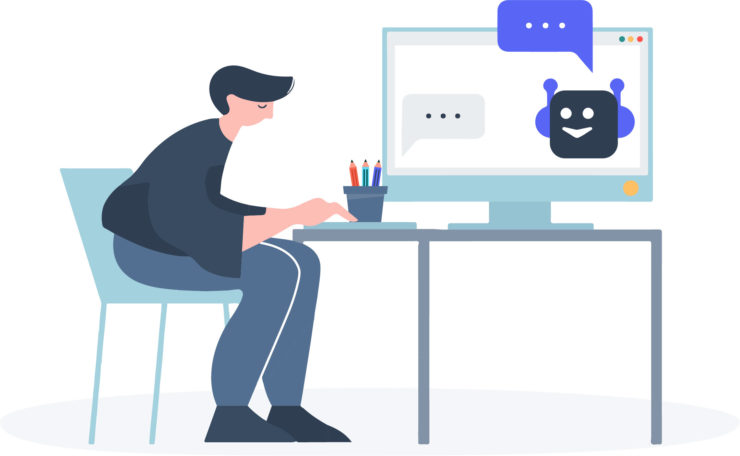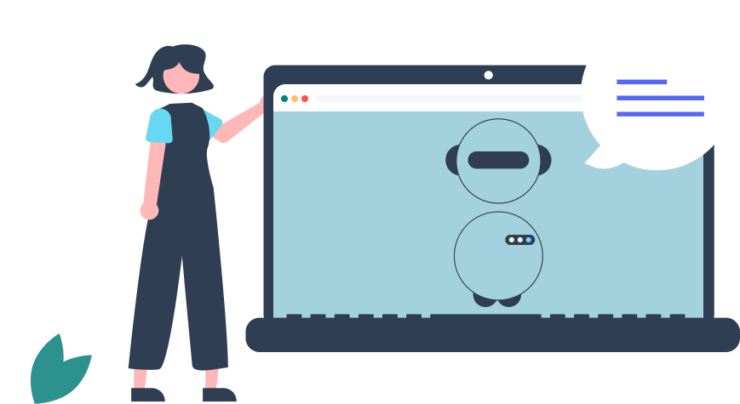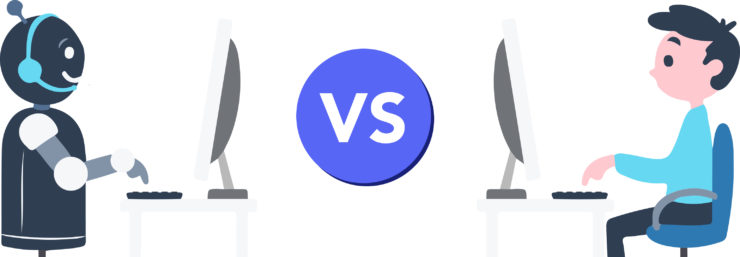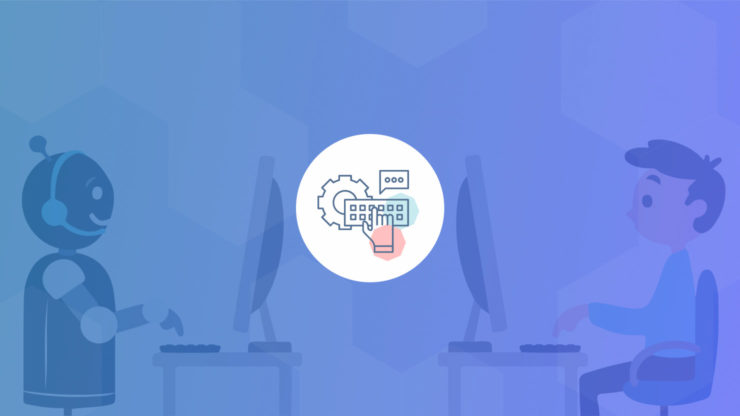Have we finally moved past the dreaded phone call waiting line? I can hear you cheering from the other side of the screen. Since the introduction of Live Chat and Chatbots, so have we.
Chat support is becoming more common as we advance into a more technologically advanced world. When you visit a website with a burning question, that little pop-up box is the perfect alert to greet you. Cue the sighs of relief!
Throughout this post, we will review two of the most popular customer service strategies for 2022: Live Chat Vs. Chatbots. What is the difference between Live Chat and Chatbots, you ask? We’ll highlight everything you need to know as a small to medium-sized business, including:
- What is Live Chat?
- What is a Chatbot
- Summary: When to use Live Chat and Chatbots
- Marketing Debate Podcast

Live Chat
What is Live Chat?
Live chat is an online communication app. It allows you to interact with your customers on your website in real-time through messaging compared to email or over the phone. This option is quick and easy and answers the users within seconds. In other words, Live chat is a real person managed by service agents within a company.
Live chats offer efficient solutions to customer issues with limited frustrations. Most B2B companies have utilised this app on their websites and are converting because of it.
Do customers like Live Chat?
Consumers appreciate Live Chat because they receive an instant response. Complex queries are easily interpreted with Live chat and can process customers without the difficulty of technical terminologies. It can be significant for customers who do not yet understand your service or product.
Live chats also allow for agents to share their screens to further assist with customer queries. This option is not available to Chatbots and can be superior if your product or service requires detailed help for your customers.

Is Live Chat important?
Customers tend to prefer talking to an actual person when they have genuine questions.
Live chat widgets allow for more human connection. Humans can understand, empathize and communicate better with other humans. Your customers can get a sense of your brand and the agent’s personality, build rapport and establish an authentic relationship.
You can observe your customer through their online journey through their tone and sentiment. It can give you valuable insights to optimise for further development.
Responding quickly to a potential customer or a lead will leave them with a better impression of your business. It will be beneficial when it comes to converting.
Why use a Live Chat?
Live Chats have many benefits. Some of the main reasons to go down the Live route include:
- Improved customer experience and loyalty
- Gain valuable insights into customer
- Customer convenience
- Competitive advantages
- Expand market reach
- Fast resolutions for the customers’ problems
Live chats are a great option to create trustworthy relationships with customers and solve in-depth queries. But, as you scale up your business, handling various chats at once may not be feasible. This is where Chatbots may come into play.

ChatBots
What is a Chatbot?
A Chatbot is a programmable addition to your website that imitates human conversation through text to answer questions and queries. The Chatbot works automatically without the need for humans. When programmed correctly, Chatbots have the potential to move customers down the sales funnel more quickly.
Are Chatbots really effective?
Imagine having to reply to hundreds of customers all at once, often with the same question. If you are a small or even medium-sized business, the chances are you will not have many people available to answer questions all day. It may mean customers are still waiting for a response at the end of the day, who will later switch to your competitors.
Do customers prefer Chatbots?
Chatbots bridge human limitations and respond instantly with relevant information and guidance. It can save you money, time, and energy in the long run. These Chatbots answer questions and continue the conversation to drive customer engagement.
Chatbots generally don’t need any human intervention, which is optimal for businesses with a limited budget or employees.
Chatbots can bring value to customers by becoming a self-service source of information. This strategy allows your customers to find the information they need at any given moment. This instantaneous interaction will leave your customers feeling satisfied. That means no more listening to telephone music as you wait in line for your call to go through. We have all been there, and we all know it is not a great experience.

When to use Chatbots?
Businesses usually implement Chatbots as their primary source of information for their customers. They appear on landing pages to introduce the customer to your page and are predominantly on the Frequently Asked Questions (FAQs) page.
If the Chatbot is unable to answer the questions, it gathers enough information regarding the:
- Topic summary
- Customer details and demographic
- Product data regarding the specific product or service
The Chatbot then forwards this customer to a specific agent who can assist with the customer’s query. This approach will save your business time and energy and will result in a simple customer service workflow.
It sounds like having one less thing to worry about.
Who needs a Chatbot?
There are several reasons why your business should consider using a Chatbot, which includes:
- 24/7 customer support
- Scale-up your business
- Help your customers quicker
- Targeting millennials
- Better user interaction
- More affordable
Chatbots, however, are programmed and cannot always give answers beyond what they’re programmed to say. Although, with more and more advancements in technology, we know that it’s only a matter of time before this problem is no longer occurring.
The best thing you can do for a customer is to answer their questions. A Chatbot has a quicker response rate to humans. However, these machines still have their limitations.

How to know when to use Live Chat and Chatbots?
Chatbots can automate otherwise manual processes done by Live Chat processes. Yet, some human interactions aren’t programmable for Chatbot or other machine learning for the time being.
Trustworthiness and cost-efficiency are two of the main priorities for most small to medium businesses. When deciding whether to install Live Chat or Chatbots on your website, you must understand your customer, business goals, and feasibility.
Marketing Debate Podcast
Transcript
James Banks:
Hello everyone, welcome to another episode of the Web3 Marketing Debate Show. I’m your host, James Banks.
Joseph Chesterton:
And I’m your host, Joseph Chesterton.
James Banks:
And today, we have a niche debate. Live Chat versus Chatbots, which one is better for business? So for this debate, I’ll be backing the Chatbots, go the robots! How about you, Joe?
Joseph Chesterton:
Of course, I’m on the Live Chat side of the ring.
James Banks:
Alrighty. Well, without further ado, let’s get started. So Joe, why would you say… Or actually, I think for this one, we’re going to need a definition.
Joseph Chesterton:
Oh, I was about to say, do we need a definition?
James Banks:
We need a definition of terms. So, I’ll kick this one off. So a Chatbot, you’ve been on a website where a little bubble pops up in the corner. It asks you, “Hey, how can I help you today?” Or, “Can I help you with ‘blah’?” And it gives you some options, or prompts you to start typing.
You start typing, and then before you know it, it’s either answered your question or then it palms you off to a Live Chat operator. Which is a good segue way to explain what we mean by Live Chat, Joe?
Joseph Chesterton:
So Live Chat is, you type your message into the little Chatbox, and then someone on the other end is sitting there, and they reply back. So it’s Live chatting.
James Banks:
Yeah, of course. And it’s obvious why Chatbots is better because it’s automated. You’re not relying on a human being, and you have to pay by the hour to do this correctly. Or would you say otherwise?
Joseph Chesterton:
How many times have you gone to a website you’ve typed in, whatever it is. And then it comes back with a response that was not what you asked in the first place?
James Banks:
Is it the Chatbots’ fault, or did the person programming the Chatbot do a poor job?
Joseph Chesterton:
Isn’t the Chatbot capable of being programmed the right way in the first place?
James Banks:
Potentially. I mean, that’s arguable. But a lot of it goes down to people thinking Chatbots are genius, whizzbang AIs. They’re not. They require someone to say, “Okay, when someone says something, say this back.” And of course, you can program it for every single thing that some person could have to say, that’s not possible yet. It will be with machine learning and AI advancements.
But I think a lot boils down to whoever designed the experience of the Chatbot, which has done a poor job. It can cause the opposite of what you would have a Chatbot in the business to do. That is to improve customer experience, and it does the exact opposite. It takes away from the customer experience.
But I don’t see how Live Chat is exactly the solution to that. Joe, it could go the same way you get a poorly trained Live Chat operator and produce a negative customer experience rather than a positive one.
Joseph Chesterton:
Have you ever been to a bank and used one of the bank Live Chats?
James Banks:
Yes, it’s terrible.
Joseph Chesterton:
It’s a Chatbot. It’s not a live person. You can’t replicate the customer service of someone answering the questions straight up. I can’t remember what I was trying to do on the bank’s website, but the response was, “Do you want to sign up for a credit card?” And it was completely different from what I was doing.
James Banks:
Because the Chatbot was poorly programmed. It shouldn’t have asked you that.
Joseph Chesterton:
Maybe it was perfectly programmed. That’s the point of the bank.
James Banks:
Yeah. The bank, all they care about is bottom lines. They don’t care about customer experience.
Joseph Chesterton:
Yeah, but they should. That’s the whole point.
James Banks:
Exactly. But whose problem is that? Is it the platform, the Chatbots, or how the banks are running their business? Do you see we’re comparing apples to oranges here?
Joseph Chesterton:
Well, there’s a reason why the big four banks are in the top five biggest businesses in Australia.
James Banks:
And most top five hated organisations in the country. But let’s not get too sidetracked from what we’re debating here. All right. I’m going to throw some spanners in the works. Chatbots can be extremely useful if you understand your audience, have a good track record, and data on every single question that they have either put through from help desk, email support, or so on and so forth.
You analyse and make human-driven decisions based on how you can create and build workflows that could potentially be automating a manual activity. That means saving money and arguably producing a better customer experience because the answers are immediate. The person doesn’t have to wait to connect with a chat agent. They get their answers immediately.
Joseph Chesterton:
I was going to say that if you didn’t mention it. Which I knew you would but, that is probably the main factor, time. So people want to have the answers straight away. If you look at all the good Live Chats, either services or businesses using it properly, they’re almost instant anyway.
James Banks:
Yeah.
Joseph Chesterton:
So you could say that if you do it right, then that’s a novel point.
James Banks:
So we’ve talked a lot about chat and Chatbots for customer support. What about using them for lead generation? Like why would you say Live Chat is better than using a Chatbot for lead generation purposes?
Joseph Chesterton:
Would you say that it is a suitable lead generation?
James Banks:
Well, we’ve tested this at Web3. We’ve tested Chatbots on landing pages that drive highly relevant commercial traffic versus ones that don’t. Usually, we see at least a 30% increase in customer engagement. So when I say customer engagement, you also take that further to customer conversion.
That is someone giving us their name, email, and or phone number. We would consider that a captured lead. Having Live Chats on the website increases our ability to capture those details by approximately 30% on average. That’s through the testing that we’ve done in the past.
Joseph Chesterton:
So you’re saying that Live Chat wins?
James Banks:
No. Not necessarily because you’ve got to have someone on Live Chat, trained that knows how to handle a sales lead. And then if you want people coming into your site and hitting it 24/7, you want to resource that. It gets very costly to do.
You look at the classic multi-step form funnel, that is, we have a choice question. A classic example we use is that a free 120 point SEO audit will point out all of the problems with your website and send it back to you in a report for free in under a day. So the first step in that funnel would be for them to give us your website.
Then once we have their website, we can then usually forward them through to provide their name, email, or whatever it is, a little bit more about their business. So that would be a traditional form-based process.
You can build it into a Chatbot. It creates a more native experience, and there’s less resistance there because it doesn’t feel like they’re being pushed down a marketing funnel, even though they are. So that’s where a Chatbot can be very effective from lead generation.
Joseph Chesterton:
And I guess it goes back to your original point of, “As long as it’s been programmed, right?”
James Banks:
One hundred percent. I think this is the biggest problem. Even on both sides and particularly with Chatbots, everyone has experienced bad Chatbots. It’s not that the idea or the concept of a Chatbot is bad, or it shouldn’t be on a website. It’s whoever has built the Chatbot and the data that they fed into it, and the pathways and everything in between. They haven’t done a good job on the customer’s needs, wants, pains and desires, and then being able to provide them efficiently with good quality solutions.
A lot of that is customer experience design and customer journey mapping. We’ve done this before and do this a lot at Web3. And it’s such a critical cornerstone component to make any automated system successful. Whether it be a Chatbot or a multiform process, or even a website customer journey, per se.
Joseph Chesterton:
What I would say works well is both. So one of our service providers, they have a bot. Initially, you type in the message. If it isn’t right, then some other options potentially are. If it isn’t, then it says something like, “Speak to support.” You type that in and it goes directly to support.
James Banks:
Yeah, it checks you are a paying customer through the Chatbot. Once it figures out you’re a paying customer, it puts you in front of a person. So the person isn’t wasting their time with people that aren’t actual real paying customers. That’s a great example. And I think you’re right. We’ve learned this in many of our debates where a combination of both is the best solution.
You can use Chatbots to automate otherwise manual processes that someone in Live Chat would have to say “Tell us your name and number.” Do you know what I mean? And then save the human-based interaction for things that couldn’t be programmed in the Chatbot or through machine learning and AI for the time being that is. Would you agree, Joe?
Joseph Chesterton:
Yeah. For example, they have program responses. So it fits like 60% or even more on a growing basis based on what they’re getting, like the data that they’re getting from it.
James Banks:
Yeah.
Joseph Chesterton:
So, it’s constantly improving. And then if they can’t, obviously it just falls back to Live Chat, but it means that they then have to hire less-
James Banks:
Absolutely, at the end of the day, what business problem you’re solving, you’re making a manual process more efficient, more cost-effective, and creating more scalability in your business.
So if you’re interested in implementing Live Chat and Chatbots on your website, and you’ve got no idea how to approach it, feel free to drop us a line at web3.com.au. We’ve done this for many businesses before, and we’d love to help you out.
Joseph Chesterton:
Talk to us in our Live Chat.
James Banks:
Is that still enabled, Joe?
Joseph Chesterton:
It’s there.
James Banks:
Awesome. Well, that’s a wrap for another episode of the Web3 Marketing and Debate Show. Tune in next time, we’ll be talking to you all real soon. Have a nice day



